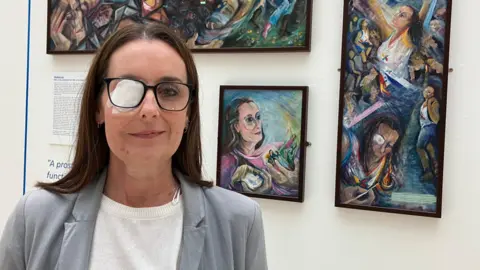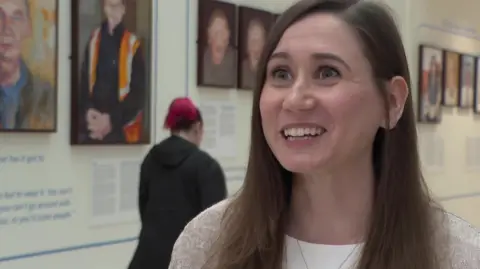'This is my face and I will embrace what I have'
 Nicola Rees/BBC
Nicola Rees/BBCA man who had his nose, eye and upper teeth removed has said an art exhibition showing his facial prosthetics reminds him he “still has a smile”.
Robin Fahey’s portrait is one of 15 unveiled at a Leeds hospital showing people with facial injuries who wear prosthetics to replace features such as an eye or a nose.
The patients, who were treated for head and neck cancer, took part in research asking them to compare the comfort of prosthetics made using different methods.
Mr Fahey said: “Although it's not perfect, this is my face and I will embrace what I have and it's up to others to embrace people like myself."
He added: “It’s fabulous because it’s showing that I have still got a smile. I couldn’t get smile before because I had nothing to smile about.
"With the prosthetic, it's back to where people can see the person you are instead of, for want of a better word, a freak, because that's how you feel."
As part of the study, the patients’ portraits were painted to help convey the physical and psychological impacts of their treatment.
Following the scheme, run by Leeds Teaching Hospitals NHS Trust and the University of Leeds, the artworks have gone on display in the Bexley Wing at St James's University Hospital.
Artist Alison Murdoch said painting Mr Fahey's portrait had been "life-changing".
"When he first walked in he was all wrapped up, virtually disguised with glasses, hat, mask," she said.
"He actually asked me if it was OK to take those items off, and that's when it hit me what his reality was."
 Nicola Rees/BBC
Nicola Rees/BBCRebecca Fogell, an NHS nurse for more than two decades, noticed a small lump near her eye in 2019 and underwent scans.
After the discovery of a tumour which had grown into bone and nerves, surgeons removed her cheekbone and part of her nose, with her eye later requiring removal.
Speaking after her four-year "medical and emotional rollercoaster", she said: "It does make me feel like I have got my face back when I look in the mirror, but I know underneath that it isn't really me anymore.
"We want to work towards acceptance and in the real world we are not quite there yet."
The research compared conventional and new digital methods of making prosthetics, with recent 3D scanning techniques found to be a less invasive way of capturing a patient’s face.
Artificial intelligence is then used to help reconstruct the facial feature, with the design later created with a 3D printer.

Dr Rachael Jablonski, who led the study, said: “We found that 90% of patients preferred digital over conventional processes due to the comfort, speed, hygiene, and perceived positive impact on outcomes associated with digital technology.
“However, the patients were also keen to ensure they would not lose out on the skilled finishing touches from the conventional approach.”
The exhibition, called I'm Still Me, runs until 31 January.
Listen to highlights from West Yorkshire on BBC Sounds, catch up with the latest episode of Look North or tell us a story you think we should be covering here.
